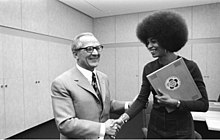Afro look

As Afro (also Afro , short Afro ) refers to a hairstyle with very curly, extending in all directions tight curls.
history
Long, unstyled, wild and curly hair became an expression of the hippie movement in the 1960s . The trend towards everything natural increased the popularity of the afro look. Due to the success of the musical Hair and the popularity of Jimi Hendrix as well as the influence of the black power movement and the American civil rights movement on Afro-Americans (Civil Rights Movement) , the Afro look was not only popular with them, but also with some whites, also outside of the USA.
The Afro-Look played a special role in the American civil rights movement , as the slogan “Black is beautiful” undermines the ideal of beauty tailored specifically to white, making “queer hair” or “nappy hair” visible on a broad basis for the first time in the USA and was worn with pride. The permanent wave for men also became socially acceptable at that time.
The popularity of the Afro look was also reflected in contemporary art of the 1970s. A prominent example of this is the graphic design of several album covers by the American jazz trumpeter and composer Miles Davis from this period, namely his albums On the Corner (1972), In Concert: Live at Philharmonic Hall (1973) and Big Fun (1974). The cartoon- style illustrations on the covers of the albums mentioned are populated by characters, many of whom wear an Afro, including caricature depictions of the musician. Another example is the cover of the album Maggot Brain (1971) by the popular US funk band Funkadelic . The person depicted on it is also wearing an afro.
hairstyle
People with straight hair model their hair in an afro look with papillots (with or without hairpins ) or twist the individual strands into cords with their fingers before winding. The hair is blow-dried and then fixed or gelled with hairspray to set the "Afro frills ".
Adaptations
- In Germany, a kind of Afro look was generally exemplified in the 1970s by soccer player Paul Breitner and Bobby Farrell , eccentric dancer from the disco group Boney M.
- The magazine Onkel Toms Faust , published from 1987 by the initiative Schwarze Deutsche , was renamed afro look from the second issue after protests over the name .
- In the 1990s, an Afro-American hip-hop project was called The Afros . The majority of the members wore an Afro look and also addressed this in their rap (“Why do I wear my 'Fro”) .
Web links
- Article in the Süddeutsche Zeitung on Afro or smooth? The fight for the right hairstyle.
- Philipp Dorestal: Dressing the Black Body. Fashion, hairstyle and being black in the USA - from the 1970s to Barack Obama. In: Zeithistorische Forschungen 14 (2017), pp. 311–336.
Individual evidence
- ↑ Afrolook on Wissen.de (accessed December 20, 2018)
- ↑ Miles Davis album On the Corner on allmusic.com, with illustration (accessed December 22, 2018)
- ↑ Miles Davis album In Concert on allmusic.com, with illustration (accessed December 22, 2018)
- ↑ Miles Davis album Big Fun on allmusic.com, with illustration (accessed December 22, 2018)
- ↑ Funkadelic album Maggot Brain on allmusic.com, with illustration (accessed December 22, 2018)
- ↑ Jeannine Kantara: The history of the "afro look" . Article by the Federal Agency for Civic Education on the journal on bpb.de (accessed December 20, 2018)
- ↑ Kickin 'Afrolistics - Afros . Music review on allmusic.com, with an illustration of the album cover (accessed December 20, 2018)
